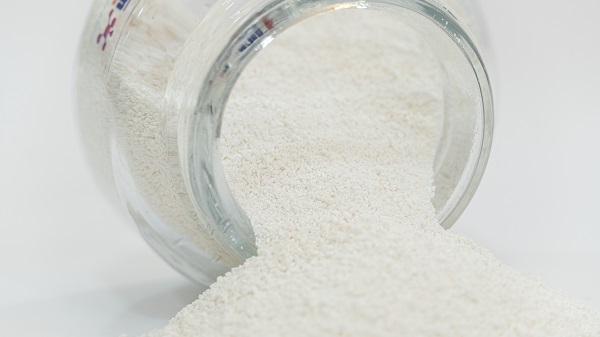Soda ash, also known as sodium carbonate (Na2CO3), is a chemical compound that has different hydrated structures. It plays a vital role in different industries such as glass manufacturing, detergent production, water treatment, and chemical synthesis. Soda ash is available in two forms: dense soda ash and light soda ash. In this article, we provide information about the characteristics, uses, and differences between dense and light soda ash.
What is Soda ash?

Soda ash is the commercial name of sodium carbonate, with the chemical formula Na2CO3. It is a white, odorless, and granular powder with a pH of around 11. Soda ash is soluble in water and forms an alkaline solution. In terms of specifications, Soda ash is divided into two categories: Soda ash dense and Soda ash light. The main difference between dense and light soda ash is in the density and type of use. Particle size is also different in these two types.
Dense soda ash
Dense soda ash, also known as heavy soda ash, is produced through the Solvay process, which involves the chemical reaction between sodium chloride (salt) and limestone. Dense soda ash is typically obtained in the form of a white, crystalline solid with a high density.
Characteristics and properties of dense soda ash
Dense soda ash has a higher density in comparison with light soda ash, ranging from 0.9 to 1.1 g/cm³. It appears as dense particles, granules, or small crystals. Due to its low water content, it is less hygroscopic than light soda ash, meaning it has a lower tendency to absorb moisture from the air.
Uses and applications of dense soda ash
Dense soda ash has different applications in various industries. Some uses include:
Glass manufacturing: Dense soda ash is a vital ingredient in the production of glass. It acts as a fluxing agent, lowering the melting point of silica and facilitating the formation of glass.
Chemical manufacturing: Dense soda ash is used in the production of various chemicals. It is used in the synthesis of sodium bicarbonate, sodium silicates, and sodium phosphates. These chemicals have applications in different industries such as detergents, pulp and paper, textiles, and water treatment.
Water treatment: Dense soda ash is used in water treatment processes, particularly for pH adjustment and alkalinity control. It is utilized to neutralize acidic water and increase the alkalinity of water, making it suitable for various industrial applications.
Light soda ash
Light soda ash, also known as soda ash light, is produced through the recrystallization of dense soda ash. It undergoes a refining process that removes impurities and excess water, resulting in a product with a lower density and higher water content in comparison with dense soda ash.
Characteristics and properties of light soda ash
Light soda ash is characterized by lower density, typically ranging from 0.5 to 0.6 g/cm³. It appears as fine, white particles or powder. Light soda ash has a higher hygroscopic nature, meaning it readily absorbs moisture from the air.
Uses and applications of light soda ash
Light soda ash is widely used in various applications, including:
Detergent production: Light soda ash is a vital ingredient in the manufacturing of detergents and cleaning products. It acts as a pH regulator, helping to maintain the appropriate alkalinity for efficient cleaning.
Textile industry: Light soda ash is used in the textile industry. It helps fix dyes to the fabric, improve color brightness, and ensure color fastness.
Water treatment: light soda ash, like dense soda ash, is used in water treatment processes. It is used for pH adjustment and alkalinity control in swimming pools and industrial water treatment systems.
Differences between dense and light soda ash
Dense and light soda ash are both chemicals with diverse industrial applications. Dense soda ash is known for its high density and low water content. On the other hand, light soda ash has a lower density and higher water content. Understanding the differences between these two forms of soda ash is very important for selecting a suitable product for industrial processes. Some differences between dense and light soda ash include:
Density: The main difference between dense and light soda ash is in their density. Dense soda ash has a higher density in comparison with light soda ash.
Water Content: Dense soda ash has a lower water content, while light soda ash has a higher water content due to the refining process.
Hygroscopic Nature: Dense soda ash is less hygroscopic in comparison with light soda ash. Light soda ash readily absorbs moisture from the air.
Applications: Dense soda ash is commonly used in glass manufacturing and chemical synthesis, while light soda ash has extensive use in detergent production, textiles, and water treatment.
FAQ
What is the difference between light and dense soda ash?
Dense soda ash is known for its high density and low water content. It is suitable for glass manufacturing and chemical synthesis. On the other hand, light soda ash has a lower density and higher water content. light soda ash is ideal for detergent production, textiles, and water treatment.
What is dense soda ash used for?
Dense soda ash has a higher density in comparison with light soda ash. It is mostly used in the glass industry, chemical manufacturing, and water treatment.
What is light soda ash used for?
Light soda ash is characterized by lower density. It is mostly used in detergent production, textile industry, and water treatment.
